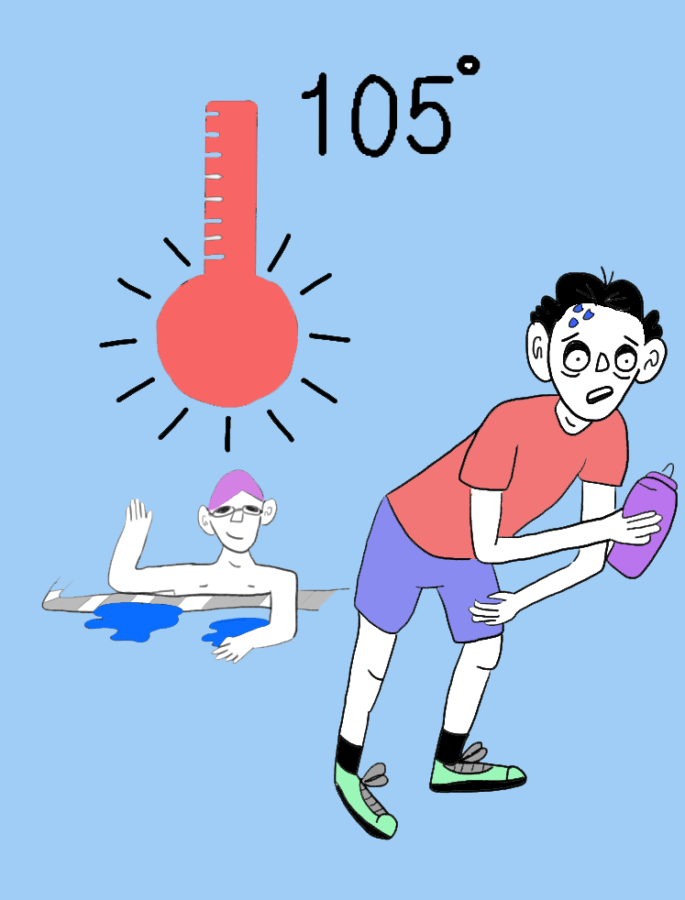Bringing Down the Heat Index to Bring Up Our Athletes
With rising temperatures and fall sports in full swing, it is important to revise the current heat index in order to protect athletes of certain sports from the dangers of playing in extreme temperatures.
The heat index, according to the National Oceanic and Atmospheric Administration, is “what the temperature feels like to the human body when relative humidity is combined with the air temperature.”
Currently, IUSD issues the school’s heat index, and the red flag heat index, or the maximum playable condition, is from 100 degrees to 105 degrees depending on humidity for all sports. It is extremely concerning that all sports, despite having varying levels of intensity, lengths and field conditions, follow the same heat index.
“I feel like [the heat index] doesn’t really affect water polo because we’re in the water, and the water just cools us down,” varsity water polo player and senior Shadi Charara said. “It doesn’t really affect our conditions to play anything.”
Many sports’ fields such as the turf or the tennis courts increase the ‘feels-like’ temperature because the fields absorb heat, according to BBC News, making conditions even more dangerous. The pool, however, may lower the ‘feels-like’ temperature for players.
“The turf adds 10 to 15 degrees,” varsity football player and junior Aidan Russell said. “It affects football a lot but maybe doesn’t affect us as much as other sports. The other sport I play is baseball, where it does get really hot.”
Playing in such extreme temperatures on fields that only amplify the effects of the heat make players susceptible to heat related illnesses, which can lead to long-term negative consequences for athletes.
“So what happens is people end up becoming dehydrated. They’ll start having things, symptoms. Cramps will start showing up, nausea, just feeling like they’re fatigued, really fatigued” school nurse James Matejcek said. “If they do not get off that field at that time, and they do not seek to get into a cooler place and start rehydrating themselves, they have a real risk of having heat stroke, and once a person has heat stroke . . . it puts you at an extreme risk of death.”
The heat index must be lowered by five degrees Fahrenheit for all turf sports and tennis to ensure the safety of all athletes, and aquatic sports can continue following the current heat index, as there is a significantly reduced risk of heat illnesses when in the water, according to the Mayo Clinic. Since the current heat index is already measured in five degree intervals, moving every index down by five degrees will ensure a smooth transition into a more tolerant index.
The current suggested procedures to combat heat do not specify what changes coaches should make. For example, the current procedures ask coaches to run “practices/competitions with significant modifications.” Every coach may have different interpretations of “significant modifications,” possibly leading to inadequate changes to practice, endangering students.
A more efficient and explicit way to direct coaches would be to describe specific actions or drills that should not be run in certain temperatures. For example, a statement like “football players are not allowed to participate in any contact drills on a red flag day” would ensure athletes are protected and reduce the risk of heat illnesses.
By reducing the heat index for all outdoor, non-aquatic sports by five degrees and describing specific steps for coaches that are unique for each sport to combat the heat, the district will ensure all student-athletes are safe.
Your donation will support the student journalists of Portola High School. Your contribution will allow us to purchase equipment and cover our annual website hosting costs.

Manan Mendiratta is the Sports Editor for the 2019-2020 school year. This is Manan’s first time in the Portola Pilot, so he is extremely excited to contribute...

Nate Taylor is the 2021-22 front page editor and photo editor. He is ready to improve his design skills and create memorable Portola Pilot front covers....




